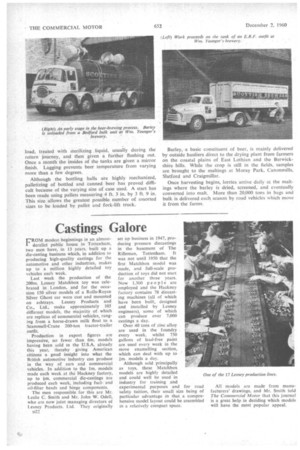Castings Galore
Page 64

If you've noticed an error in this article please click here to report it so we can fix it.
FROM modest beginnings in an almostI derelict public house in Tottenham, two men have, in 13 years, built up a die-casting business which, in addition to producing high-quality castings for the automotive and other industries, makes up to a million highly detailed toy vehicles each week.
Last week the production of the 200m. Lesney Matchbox toy was celebrated in London, and for the occasion 150 silver models of a Rolls-Royce Silver Ghost car were cast and mounted on ashtrays. Lesney Products and Co., Ltd., make approximately 105 different models, the majority of which are replicas of commercial vehicles, ranging from a horse-drawn milk float to a Scammell-Crane 200-ton tractor-trailer outfit.
Production in export figures are impressive, no fewer than 6m. models having been sold in the U.S.A. already this year, thereby giving American citizens a good insight into what the British automotive industry can produce in the way of cars and commercial vehicles. In addition to the 1m. models made each week at the Hackney factory, up to 1m. commercial die-castings are produced each week, including fueland oil-filter heads and hinge components.
The men responsible for this are Mr. Leslie C. Smith and Mr. John W. Odell, who are now joint managing directors of Lesney Products, Ltd. They originally D22 set up business in 1947, producing pressure diecastings in the basement of The Rifleman, Tottenham. It was not until 1950 that the first Matchbox model was made, and full-scale production of toys did not start for another three years. Now 1,300 people are employed and the Hackney factory contains 78 diecasting machines (all of which have been built, designed and installed by Lesney engineers), some of which can produce over 7,000 castings a day.
Over 40 tons of zinc alloy are used in the foundry every week, whilst 750 gallons of lead-free paint are used every week in the stove enamelling section, which can deal with up to lm. models a day.
Although sold principally as toys, these Matchbox models are highly detailed and could well be used in industry for training and experimental purposes and for road safety tuition, their small size being of particular advantage in that a comprehensive model layout could be assembled in a relatively compact space. All models are made from manufacturers' drawings, and Mr. Smith told The Commercial Motor that this journal is a great help in deciding which models will have the most popular appeal.




















































































































